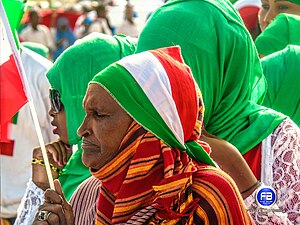Somalilanders
Script error: No such module "Draft topics". Script error: No such module "AfC topic".
Somalilanders, also referred to as Somaliland nationals or Somaliland citizens, are a distinct and diverse ethnic group primarily residing in the self-declared state of Somaliland. While not internationally recognized as an independent nation, Somalilanders possess a unique cultural identity, language, and history that distinguish them within the broader Somali population. This article delves into the key aspects of Somalilanders' identity, their cultural heritage, social structure, and contributions to various fields.

Cultural Identity and Heritage[edit]
Somalilanders' cultural identity is deeply rooted in their historical interactions with neighboring civilizations, including Arab traders and the Axumite Empire. This blend of influences has shaped their language, traditions, and way of life. The majority of Somalilanders are ethnically Somali and speak the Somali language, which plays a pivotal role in preserving their history and facilitating communication across diverse clans and regions.
Clan Structure and Unity[edit]
Historically, Somalilanders have organized themselves into clans, social units formed around lineage and ancestral ties. While clan divisions have at times led to internal strife, they also serve as a foundation for communal identity. Efforts have been made to reconcile differences and foster national cohesion, with Somalilanders often prioritizing their shared interests over clan affiliations.
Diaspora Influence[edit]
Somalilanders have a significant diaspora scattered across different continents, contributing to the economies and cultural landscapes of host countries. This diaspora maintains strong ties to their homeland, supporting development projects, advocating for international recognition, and participating in cultural exchanges that help preserve their heritage.
Education and Intellectual Pursuits[edit]
Education is highly valued among Somalilanders, reflecting their commitment to personal growth and community development. Despite challenges, many Somalilanders have excelled in academic and professional fields, both within Somaliland and abroad. This dedication to education underscores their resilience and determination to overcome obstacles.
Cultural Expressions and Arts[edit]
Artistic expressions hold a prominent place in Somalilanders' lives, serving as a medium to showcase their identity and emotions. Intricate henna designs, colorful clothing, and traditional music are integral to their cultural heritage. Somalilanders also embrace contemporary art forms, contributing to a diverse and evolving artistic landscape.
Entrepreneurial Endeavors[edit]
The entrepreneurial spirit is deeply ingrained among Somalilanders, who actively engage in various economic activities. From bustling urban markets to rural trade networks, their ability to adapt and innovate has contributed to local economies. Small businesses thrive, reflecting their resourcefulness and commitment to self-sufficiency.
Conclusion[edit]
Despite not being recognized as a sovereign nation, Somalilanders stand out as a resilient and culturally rich community. Their unique language, traditions, and sense of unity define their identity. The Somalilanders' story is one of embracing diversity, overcoming challenges, and preserving their heritage against all odds. While their aspirations for international recognition continue, their impact on their homeland and the world remains substantial.
References[edit]
List of Somalilanders[edit]
People of Somaliland
This article "Somalilanders" is from Wikipedia. The list of its authors can be seen in its historical and/or the page Edithistory:Somalilanders. Articles copied from Draft Namespace on Wikipedia could be seen on the Draft Namespace of Wikipedia and not main one.
